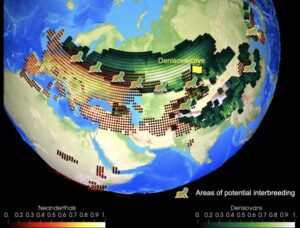
AMERICAN ASSOCIATION FOR THE ADVANCEMENT OF SCIENCE (AAAS)—In two studies*, researchers demonstrate how climate modeling approaches can fill gaps in our understanding of hominin evolution and migration.
Over the last several decades, research efforts into the lives of hominins – humans and their close ancestors – have shifted from identifying fossils and artifacts to understanding the environmental and climate settings in which they lived and how these factors could have influenced hominin evolution and migration. However, like the hominin fossil record, environmental and climate records that accurately capture environmental change and span the period over which hominins evolved and spread across the globe are uncommon and incomplete. Some of these limitations can be addressed through advances in analytical tools, particularly climate and ecosystem models, which can help fill these gaps and provide valuable new insights into hominin migration.
In one study, Vasiliki Margari and colleagues used a deep-sea sediment core, which provided a temperature record for Europe from 800,000 to 1.8 million years ago. Using these data, the authors created a climate envelope model and evaluated the geographic range of hominin species using climate variables such as temperature and precipitation. Margari et al. discovered hominin presence around the Mediterranean before ~1.1 million years ago was characterized by long, stable interglacial conditions with short glacials that would have allowed for hominin establishment and long-term occupation. However, extreme glacial conditions beginning around 1.1 million years ago would likely have made the region too cold for hominins to survive. Margari et al. argue that these extreme conditions likely led to the depopulation of Europe, which could have lasted for several glacial-interglacial cycles.
In another study, Jiaoyang Ruan and colleagues evaluate how climate shifts across central Eurasia during the Pleistocene could have facilitated interbreeding between Denisovans and Neanderthals. Genetic studies have revealed evidence of interbreeding between Neanderthals and Denisovans in Eurasia. However, much about these admixture events remains unknown. Here, Ruan et al. developed a species distribution model combining extensive fossil, archaeological, and genetic data with transient coupled general circulation model simulations of global climate and habitat change for the past 400,000 years, which was used to determine the habitat preferences for both Neanderthals and Denisovans. The authors found that, although both species lived in a variety of environments, Neanderthals preferred temperate forests, whereas Denisovans lived in a much wider range of habitats. However, orbitally driven climate shifts in habitat caused the preferred habitats of Denisovans and Neanderthals to overlap, providing opportunities for interbreeding between the two species.
_________________________________

Figure showing interbreeding between Neanderthals and Denisovans. Made by Axel Timmermann using Paraview software
_________________________________
By Walter Beckwith
Article Source: AAAS news release
*Extreme glacial implies discontinuity of early hominin occupation of Europe. Science, 11- Aug- 2023. 10.1126/science.adf4445
*Climate shifts orchestrated hominin interbreeding events across Eurasia, Science, 11- Aug- 2023. 10.1126/science.add4459
_________________________________
Advertisement





